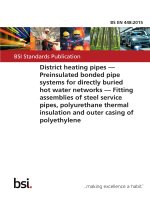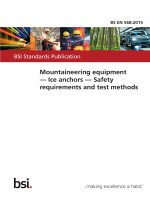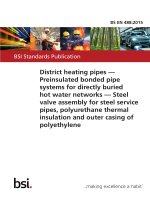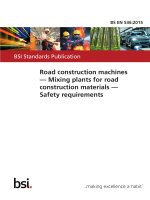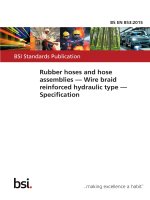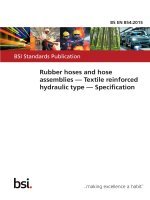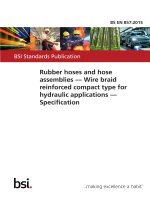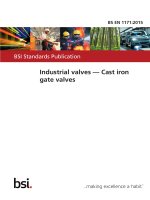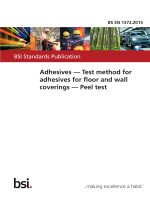Bsi bs en 16693 2015
Bạn đang xem bản rút gọn của tài liệu. Xem và tải ngay bản đầy đủ của tài liệu tại đây (1.26 MB, 34 trang )
BS EN 16693:2015
BSI Standards Publication
Water quality — Determination
of organochlorine pesticides
(OCP) in whole water samples
— Method using solid phase
extraction (SPE) with SPEdisks combined with gas
chromatography mass
spectrometry (GC-MS)
BS EN 16693:2015
BRITISH STANDARD
National foreword
This British Standard is the UK implementation of EN 16693:2015.
The UK participation in its preparation was entrusted to Technical
Committee EH/3/2, Physical chemical and biochemical methods.
A list of organizations represented on this committee can be
obtained on request to its secretary.
This publication does not purport to include all the necessary
provisions of a contract. Users are responsible for its correct
application.
© The British Standards Institution 2015.
Published by BSI Standards Limited 2015
ISBN 978 0 580 84519 2
ICS 13.060.50
Compliance with a British Standard cannot confer immunity from
legal obligations.
This British Standard was published under the authority of the
Standards Policy and Strategy Committee on 30 September 2015.
Amendments/corrigenda issued since publication
Date
Text affected
BS EN 16693:2015
EN 16693
EUROPEAN STANDARD
NORME EUROPÉENNE
EUROPÄISCHE NORM
September 2015
ICS 13.060.50
English Version
Water quality - Determination of organochlorine
pesticides (OCP) in whole water samples - Method using
solid phase extraction (SPE) with SPE-disks combined
with gas chromatography mass spectrometry (GC-MS)
Qualité de l'eau - Dosage des pesticides organochlorés
(POC) dans la totalité de l'échantillon d'eau - Méthode
par extraction en phase solide (SPE) avec disques SPE,
avec couplage chromatographie en phase gazeusespectrométrie de masse (CG-SM)
Wasserbeschaffenheit - Bestimmung von
Organochlorpestiziden (OCP) in Gesamtwasserproben
- Verfahren mittels Festphasenextraktion (SPE) mit
SPE-Disks in Verbindung mit Gaschromatographie Massenspektrometrie (GC-MS)
This European Standard was approved by CEN on 27 June 2015.
CEN members are bound to comply with the CEN/CENELEC Internal Regulations which stipulate the conditions for giving this
European Standard the status of a national standard without any alteration. Up-to-date lists and bibliographical references
concerning such national standards may be obtained on application to the CEN-CENELEC Management Centre or to any CEN
member.
This European Standard exists in three official versions (English, French, German). A version in any other language made by
translation under the responsibility of a CEN member into its own language and notified to the CEN-CENELEC Management
Centre has the same status as the official versions.
CEN members are the national standards bodies of Austria, Belgium, Bulgaria, Croatia, Cyprus, Czech Republic, Denmark, Estonia,
Finland, Former Yugoslav Republic of Macedonia, France, Germany, Greece, Hungary, Iceland, Ireland, Italy, Latvia, Lithuania,
Luxembourg, Malta, Netherlands, Norway, Poland, Portugal, Romania, Slovakia, Slovenia, Spain, Sweden, Switzerland, Turkey and
United Kingdom.
EUROPEAN COMMITTEE FOR STANDARDIZATION
COMITÉ EUROPÉEN DE NORMALISATION
EUROPÄISCHES KOMITEE FÜR NORMUNG
CEN-CENELEC Management Centre: Avenue Marnix 17, B-1000 Brussels
© 2015 CEN
All rights of exploitation in any form and by any means reserved
worldwide for CEN national Members.
Ref. No. EN 16693:2015 E
BS EN 16693:2015
EN 16693:2015 (E)
Contents
Page
European foreword....................................................................................................................................................... 3
Introduction .................................................................................................................................................................... 4
1
Scope .................................................................................................................................................................... 5
2
Normative references .................................................................................................................................... 7
3
Principle ............................................................................................................................................................. 7
4
4.1
4.2
Interferences .................................................................................................................................................... 7
Interferences with sampling and extraction ......................................................................................... 7
Interferences with GC-MS ............................................................................................................................. 8
5
Reagents ............................................................................................................................................................. 8
6
Apparatus........................................................................................................................................................... 9
7
Sampling .......................................................................................................................................................... 10
8
8.1
8.2
8.3
8.4
8.5
8.6
Procedure........................................................................................................................................................ 10
Sample preparation and extraction ...................................................................................................... 10
Extraction by SPE-disks ............................................................................................................................. 11
Solvent concentrating ................................................................................................................................. 11
Gas chromatography ................................................................................................................................... 12
Identification of individual compounds by means of GC-MS ........................................................ 12
Blank value measurements ...................................................................................................................... 12
9
9.1
9.2
9.3
9.4
Calibration ...................................................................................................................................................... 13
General requirements ................................................................................................................................ 13
Calibration of the GC-step ......................................................................................................................... 14
Calibration of the total procedure using the internal standard .................................................. 14
Determination of procedural recovery values .................................................................................. 15
10
Calculation of the results ........................................................................................................................... 16
11
Expression of results................................................................................................................................... 17
12
Test report ...................................................................................................................................................... 17
Annex A (informative) Suitable gas chromatographic conditions and example
chromatograms — GC-conditions of example chromatograms in Figure A.1 ........................ 18
Annex B (informative) Repeatability and reproducibility data ............................................................... 23
Annex C (informative) Examples of suitable SPE-disks ............................................................................... 27
Annex D (informative) Examples of internal standards ............................................................................. 28
Bibliography ................................................................................................................................................................. 29
2
BS EN 16693:2015
EN 16693:2015 (E)
European foreword
This document (EN 16693:2015) has been prepared by Technical Committee CEN/TC 230 “Water
analysis”, the secretariat of which is held by DIN.
This European Standard shall be given the status of a national standard, either by publication of an
identical text or by endorsement, at the latest by March 2016, and conflicting national standards shall
be withdrawn at the latest by March 2016.
This document has been prepared under a mandate given to CEN by the European Commission and the
European Free Trade Association.
Attention is drawn to the possibility that some of the elements of this document may be the subject of
patent rights. CEN [and/or CENELEC] shall not be held responsible for identifying any or all such patent
rights.
According to the CEN/CENELEC Internal Regulations, the national standards organisations of the
following countries are bound to implement this European Standard: Austria, Belgium, Bulgaria,
Croatia, Cyprus, Czech Republic, Denmark, Estonia, Finland, Former Yugoslav Republic of Macedonia,
France, Germany, Greece, Hungary, Iceland, Ireland, Italy, Latvia, Lithuania, Luxembourg, Malta,
Netherlands, Norway, Poland, Portugal, Romania, Slovakia, Slovenia, Spain, Sweden, Switzerland,
Turkey and the United Kingdom.
3
BS EN 16693:2015
EN 16693:2015 (E)
Introduction
WARNING — Persons using this European Standard should be familiar with usual laboratory
practice. This European Standard does not purport to address all of the safety problems, if any,
associated with its use. It is the responsibility of the user to establish appropriate safety and
health practices and to ensure compliance with any national regulatory conditions.
IMPORTANT — It is absolutely essential that tests conducted according to this European
Standard be carried out by suitably trained staff.
Organochlorine pesticides (OCP) are priority substances listed in Annex X of the EU Water Framework
Directive (WFD, Directive 2000/60/EC) for which environmental quality standards (EQS) have been set
at EU level for inland waters as well as other surface waters to protect the aquatic environment against
chemical pollution (Directive 2008/105/EC). With the exception of metals, the EQSs are expressed as
total concentrations in the whole water sample. Furthermore, analytical methods used in WFD
monitoring need to meet certain requirements as regards the minimum limit of quantification and the
maximum tolerable measurement uncertainty (Directive 2009/90/EC). So far, there is no Europeanwide standardized method available for the determination of OCP in whole water samples fulfilling
those requirements. Hence, the European Commission mandated CEN to develop or improve standards
in support of the implementation of the monitoring requirements of WFD.
Directive 2008/105/EC has been amended by Directive 2013/39/EU, however this standard has been
developed for the analysis of OCP as listed in Annex A of Directive 2008/105/EC.
The priority substances list in Annex X of the WFD includes various OCPs such as alachlor, endosulfan,
hexachlorobenzene, hexachlorocyclohexane isomers, pentachlorobenzene, aldrin, dieldrin, endrin,
isodrin, DDT and its metabolites. Annual average environmental quality standards (AA-EQS) values for
individual OCP range from 0,000 5 µg/l to 0,3 µg/l and are defined for the concentration in the whole
water sample, including suspended particulate matter (SPM) present in the sample. As long as
compounds such as OCP, in particular the larger molecular weight ones, sorb strongly to environmental
solids, the fraction bound to particles may be substantial. Therefore it is important to be able to handle
whole water samples within the analytical process. Identification and quantification of OCP at trace
level concentrations often require both high sensitive chromatographic equipment and effective
enrichment steps.
4
BS EN 16693:2015
EN 16693:2015 (E)
1 Scope
This European Standard specifies a method for the determination of selected organochlorine pesticides
(OCP) (see Table 1), in water samples. The method uses solid-phase extraction with SPE-disks followed
by gas chromatography-mass spectrometry (GC-MS). It is applicable to the analysis of OCPs in surface
water containing suspended particulate matter (SPM) up to 500 mg/l (whole water samples), drinking
water and groundwater. The lower limit of the working range depends on the matrix, on the specific
compound to be analyzed and on the sensitivity of the mass spectrometric detection unit. For
compounds listed in Table 1 the limit of determination (LOQ) is at least 30 % of the corresponding AAEQS value (0,000 15 µg/l to 0,1 µg/l) according to the requirements of the European Quality Standards
Directive (Directive 2008/105/EC) for both inland surface waters and other surface waters.
This method may be used for the analysis of other OCPs not listed in Table 1 or other types of water.
However, it is important to verify its applicability before use.
5
BS EN 16693:2015
EN 16693:2015 (E)
Table 1 — Organochlorine pesticides (OCP) determined by this method
Substance
Molecular formula
Molar mass
g/mol
EC Number a
CAS RN b
Alachlor
C14H20ClNO2
269,77
240–110–8
15972–60–8
Aldrin
C12H8Cl6
364,91
206–215–8
309–00–2
364,91
207–366–2
465–73–6
Cyclodiene pesticides:
Dieldrin
Endrin
Isodrin
DDT-total:
op´-DDT
pp´-DDT
pp´-DDD
pp´-DDE
Hexachlorobenzene (HCB)
Hexachlorobutadiene (HCBD)
Hexachlorocyclohexane c:
C12H8Cl6O
C12H8Cl6O
C12H8Cl6
380,91
380,91
200–484–5
200–775–7
60–57–1
72–20–8
C14H9Cl5
C14H9Cl5
354,49
212–332–5
789–02–6
C6Cl6
318,03
284,80
200–784–6
72–55–9
C14H9Cl4
C14H9Cl4
C4Cl6
354,49
320,04
260,76
200–024–3
200–783–0
50–29–3
72–54–8
204–273–9
118–74–1
201–765–5
87–68–3
beta-HCH
C6H6Cl6
C6H6Cl6
290,83
206–270–8
319–84–6
Pentachlorobenzene
C6HCl5
290,83
250,34
200–401–2
58–89–9
alpha-HCH
delta-HCH
gamma-HCH
Trichlorobenzene c:
1,2,3-TCB
1,2,4-TCB
1,3,5-TCB
Endosulfan c:
Endosulfan-I (alpha)
Endosulfan-II (beta)
a
b
c
6
C6H6Cl6
C6H6Cl6
290,83
290,83
206–271–3
206–272–9
210–172–0
C6H3Cl3
181,45
201–757–1
C9H6Cl6O3S
406,93
–
C6H3Cl3
C6H3Cl3
C9H6Cl6O3S
181,45
181,45
406,93
204–428–0
203–608–6
–
319–85–7
319–86–8
608–93–5
87–61–6
120–82–1
108–70–3
959–98–8
33213–65–9
EC Number: European inventory of existing commercial substances (EINECS) or European list of notified chemical substances
(ELINCS).
CAS RN: Chemical Abstracts Service Registry Number.
Mixture of isomers.
BS EN 16693:2015
EN 16693:2015 (E)
2 Normative references
The following documents, in whole or in part, are normatively referenced in this document and are
indispensable for its application. For dated references, only the edition cited applies. For undated
references, the latest edition of the referenced document (including any amendments) applies.
EN ISO 3696, Water for analytical laboratory use - Specification and test methods (ISO 3696)
EN ISO 5667-3, Water quality - Sampling - Part 3: Preservation and handling of water samples (ISO 56673)
3 Principle
Organochlorine pesticides present in the whole water sample are extracted by means of solid-phase
extraction using solid-phase extraction disks (SPE-disks). Samples shall not be filtered. An internal
standard mixture is added to the sample prior to extraction. Extraction by SPE-disks is a fully
automatable procedure. It includes a combined extraction of both the analytes dissolved in the liquid
phase of the sample and those adsorbed to the suspended particulate matter. The latter is extracted
within the elution step of the procedure.
The extract is concentrated by evaporation and the analytes are separated, identified and quantified by
capillary gas chromatography with mass spectrometric detection (GC-MS) using electron impact (EI)
ionization mode. The compounds endosulfan-I (alpha) and endosulfan-II (beta) may require additional
efforts on either enlargement of sample enrichment and/or large volume injection (LVI) of sample
extract. Enlargement of sample enrichment can be achieved by using 2 000 ml sample volume and/or
an evaporation of solvent extracts down to a final volume of 0,2 ml or 0,1 ml.
4 Interferences
4.1 Interferences with sampling and extraction
To avoid interferences, collect samples according to Clause 7. Sample containers shall consist of
materials that do not alter the sample during the contact time. Plastics and other organic materials shall
be avoided during sampling or sample storage.
Commercially available SPE-disks can differ frequently in quality. Variations in the selectivity of the
materials can occur from batch to batch, and therefore might cause significant deviations in the
extraction yield. This does not basically impair their suitability, apart from a resulting higher detection
limit of individual substances. To ensure that the measuring results have a high accuracy and precision,
use materials of one batch for both measurement and calibration. Avoid major fluctuations in the
extraction times and elution procedures within one sample sequence when analyzing the samples.
Make sure that the disk is effectively dried. This can be achieved by using e.g. a vacuum device equipped
with a device to dry a stream of nitrogen or air before it is applied to the disk. If the vacuum based
automated or manually driven equipment uses ambient air from the laboratory environment, which
often contains a certain degree of humidity, drying of the disk is, depending from the moisture content
of the air, not effective and often results in a high amount of residual water in the disk (e.g. > 200 µl).
Therefore additional drying of air before it is applied to the disk is required, e.g. by integration of a
drying flask containing calcium chloride (5.9) or another drying agent (desiccant). This procedure
results in very effectively dried disks with low remaining water (<10 µl per disk).
If the applied automated system is not able to process disk drying by using dry nitrogen or dry air, take
out the disk for drying and continue, if appropriate, manually as described above.
Extending the drying time does not lead to efficiently dried SPE-disks. Avoid any prolongation of the
recommended disk drying process (see 8.2), because this results in low recoveries for some of the
7
BS EN 16693:2015
EN 16693:2015 (E)
medium volatile compounds (e.g. 1,2,3-TCB, 1.2.4-TCB and 1,3,5-TCB). The use of a labelled standard
for TCBs is recommended.
Acetone is the recommended solvent for extraction and elution (see 8.2). Do not apply any solvent
drying step on acetone. As long as the residual water in the disk after disk drying is, as described above,
within the range of just a few µl per disk, there will no interferences occur in GC-MS analysis.
4.2 Interferences with GC-MS
Interferences may be caused, e.g. by the injection system used or by inadequate separation of the
analytes. Substances with similar retention times and producing similar masses compared with the
analytes to be determined may interfere with the determination. These interferences may lead to
incompletely resolved signals. Experienced operators, using the information given in the instrument
manuals, may be able to minimize this type of interference. Regular checking of the chromatographic
and spectrometric system is required to maintain adequate performance. Required system stability
should be checked regularly using a GC standard.
5 Reagents
The reagents shall be free from impurities possibly interfering with the GC-MS analysis.
Use solvents and reagents of sufficient purity, i.e. with negligibly low impurities compared with the
concentration of analytes to be determined. As reagents use, as far as available, “residual grade”,
“picograde” or better in order to obtain clean blanks. Check blanks regularly and establish proper
charge control. If necessary, apply additional cleaning steps.
5.1
Water, complying to grade 1 according to EN ISO 3696, or equivalent.
5.2 Operating gases for the gas chromatography mass spectrometry, of high purity and according to
the manufacturer's specifications.
5.3
5.4
Nitrogen of high purity, i.e. minimum 99,996 % by volume, for concentration by evaporation.
Solvents for extraction, chromatography and preparation of reference solutions.
A variety of solvents may be used depending on the procedural step and the availability of commercial
stock solutions, e.g.
— acetone, C3H6O (boiling point: 56 °C),
— ethyl acetate, C4H8O2 (boiling point: 77 °C),
— iso-octane (2,2,4-trimethylpentane), C8H18 (boiling point: 99 °C),
— cyclohexane, C6H12 (boiling point: 81 °C),
— toluene, C7H8 (boiling point: 111 °C).
5.5
Sodium hydroxide solution, w(NaOH) = 25 % mass fraction.
5.6 Hydrochloric acid, w(HCl) = 25 % mass fraction or sulfuric acid, w(H2SO4) = 12,5 % mass
fraction.
8
BS EN 16693:2015
EN 16693:2015 (E)
5.7
Internal standard
It is highly recommended to use a deuterium-labelled or 13C-enriched substance of those listed in
Table 1 as internal standard. Examples for suitable internal standards are given in Annex D. For further
information see 9.3.
Prepare stock solutions of individual internal standard substances in the same way as specified for
individual reference substances (5.8.2) or use commercially available certified solutions of individual
substances (e.g. in acetone). Prepare spiking solutions for spiking the samples (see 8.1) by further
diluting the stock solutions with a water soluble solvent e.g. acetone (5.4).
5.8
5.8.1
Reference substances
General requirements
Reference substances (OCP, listed in Table 1) of defined concentration, suitable for the preparation of
reference solutions used for gas chromatography and spiking of water samples for calibration of the
total procedure (see 9.3) and calculation of the overall recovery (see 9.4).
5.8.2
Stock solutions of individual reference substances
For example, place 50 mg of a reference substance and/or the internal standard substances (5.7) into a
100 ml volumetric flask (6.2), dissolve in an appropriate solvent (5.4) and make up to the mark with the
same solvent.
Store stock solutions at temperatures between 1 °C and 5 °C, protected from light. Stock solutions are
stable for at least 12 months.
NOTE
5.8.3
Deep freezing of stock solutions is also possible and commonly applied.
Multi-component stock solutions of individual reference substances
For example, transfer 1 ml of each of the solutions of the individual substances (5.8.2) into a 100 ml
volumetric flask (6.2) and make up to the mark with solvent (5.4).
NOTE
Alternatively, commercially available certified stock solutions of individual (or mixtures of several)
reference substances in solvent (5.4) can be used for preparing multi-component stock solutions.
Store multi-component stock solutions at temperatures between 1 °C and 5 °C, protected from light.
Multi-component stock solutions are stable for at least 6 months.
5.8.4
Multi-component reference solutions of reference substances
Prepare multi-component reference solutions of defined concentration suitable for multipoint
calibration (working solution for GC-MS) or spiking of blank samples. Prepare solutions by dilution of
the multi-component stock solutions (5.8.3) using an appropriate solvent (5.4).
Store multi-component reference solutions at temperatures between 1 °C and 5 °C, protected from light.
Multi-component reference solutions are stable for at least 6 months.
5.9
Calcium chloride, CaCl2, for drying of air.
6 Apparatus
Equipment or parts of it which have contact with the water sample or its extract shall be free from
residues causing interferences. The use of vessels made of glass, stainless steel or
polytetrafluoroethylene (PTFE) is recommended.
9
BS EN 16693:2015
EN 16693:2015 (E)
6.1 Sample flasks, e.g. brown glass, flat bottomed, with glass or PTFE coated stoppers, e.g. 1 000 ml
or 2 000 ml.
6.2
6.3
Volumetric flasks, capacity, e.g. 10 ml, 25 ml, 50 ml and 100 ml.
Single volume pipettes, capacities between 1 ml and 50 ml.
6.4 Capillary gas chromatograph with mass spectrometric detector, (GC-MS) using EI ionization
mode, gas supply in accordance with the respective manufacturer's instructions.
6.5 Non-discriminating GC injector, e.g. splitless mode of a split or splitless injection system or
programmable temperature vaporizer (PTV) programmable for large volume injection (LVI).
6.6 Automatic sampler with option for large volume injection (LVI), including syringes for
normal injection (e.g. 1 µl and 2 µl) and LVI (e.g. 10 µl, 50 µl and 100 µl).
6.7 Capillary columns, for gas chromatography (examples of chromatograms appear in Annex A). It
is advantageous to use non-polar columns (e.g. low-bleed 5 %-phenylsiloxane column).
6.8 Solid-phase extraction disks (SPE-disks), wide inner diameter between 40 mm and 60 mm,
packed with an appropriate reversed phase adsorbent material, e.g. C18-based or SDB-based adsorbent
(for examples see Annex C).
6.9 Vacuum device for solid-phase extraction, e.g. vacubox, extraction box or automated
workstation for solid-phase extraction procedure capable for processing SPE-disks.
6.10 Equipment for concentrating the eluates by evaporation, e.g. a rotary evaporator, adjustable
for constant vacuum and with a temperature-controlled water bath, or stripping equipment using
nitrogen gas.
6.11 Pasteur pipettes.
6.12 pH-meter, with electrodes.
6.13 Drying flask.
7 Sampling
For sampling, use thoroughly cleaned sample flasks (6.1) (see EN ISO 5667-3). Fill the bottles
completely with the water to be examined.
If storage is necessary, store the samples according to EN ISO 5667-3 at (3 ± 2) °C, protected from light.
It is generally recommended to carry out the extraction as soon as practicable to minimize potential
adsorption to the glass wall.
8 Procedure
8.1 Sample preparation and extraction
The pH value of the water sample only requires adjustment if it is below (5 ± 0,2) or above (9 ± 0,2). In
this case, adjust to pH (7 ± 0,2) with hydrochloric acid (5.6), sulfuric acid (5.6) or sodium hydroxide
solution (5.5).
In general, samples are examined without pre-treatment, e.g. suspended particulate matter is not
removed prior to analysis. Do not filter the sample.
10
BS EN 16693:2015
EN 16693:2015 (E)
Large particles (e.g. leaves, little branches) should be removed using a sieve (screening gap 1 mm).
For the extraction process, add a precisely defined amount (between e.g. 50 µl to 100 µl) of the internal
standard (5.7) dissolved in an appropriate solvent (water miscible solvent, e.g. ethyl acetate or acetone,
see 5.4), to e.g. 1 000 ml of the whole water sample. Calculate the exact volume of the water sample by
weighing the sample flask before extraction and after emptying.
8.2 Extraction by SPE-disks
For conditioning of SPE-disk add an amount of acetone (6 ml to 10 ml) and let it pass through the disk
in about 20 s, e.g. using a vacuum device. Ensure that the adsorbent does not run dry.
Repeat this step once.
Add an amount of water (6 ml to 10 ml) and let it pass through the disk in about 20 s, e.g. using a
vacuum device. Ensure that the adsorbent does not run dry.
Repeat this step once.
For sample loading and extraction of analytes dissolved in the water phase take, e.g. 1 000 ml of the
sample to be examined (8.1) and pass it through the disk conditioned as described above at a flow rate
of about 50 ml/min.
To transfer particulate matter to the disk that might have remained in the bottle, rinse the sample
reservoir (e.g. the sample bottle) twice with e.g. 9 ml of water and pass it through the disk as described
above.
Effectively dry the disk using e.g. a vacuum device supported by a stream of dry nitrogen or dry air in
front of the disk for about 15 min. When using ambient laboratory air to dry the disks, additional drying
of air before applying it to the disk is necessary (see 4.1). This can be achieved e.g. by integration of a
drying flask (6.13) containing calcium chloride (5.9) or another drying agent.
NOTE
Drying of ambient laboratory air prevents reabsorption of moisture by the disk from the air sucked in.
Add an amount of acetone (6 ml to 10 ml), allowing 5 min for the solvent to soak. Collect the eluate by
passing it through the disk in about 20 s.
Add an amount of acetone (4 ml to 8 ml), allowing 5 min for the solvent to soak. Collect the eluate by
passing it through the disk in about 20 s.
Repeat the last step twice.
Collect the combined eluates in a glass vessel. No extract-drying step is required. Carefully evaporate
the solvent and concentrate the eluate as specified in 8.3.
Other solvents may be used for extraction and elution. However, their suitability should be established
in preliminary tests with blank water samples spiked with certified sediment up to 500 mg/l and
processed according to Clause 8. Recoveries for each substance under investigation should be ≥ 70 %.
8.3 Solvent concentrating
Concentrate the SPE eluate (8.2) carefully to a final volume of about 0,5 ml to 1,0 ml (e.g. in a gentle
stream of nitrogen or on a rotary evaporator under reduced pressure). To achieve higher sensitivity,
solvent evaporation can be continued to smaller final volumes (e.g. 0,1 ml). The temperature of the
eluate during concentration should be kept below 20 °C.
If a solvent change is planned, add e.g. 1 ml of an appropriate solvent (e.g. toluene) prior to solvent
concentration.
If an injection standard for volume control is intended to be used, for example, add a defined amount of
injection standard (e g. fluoranthene-D10) dissolved in acetone. In case of a planned solvent change,
injection standard may be dissolved in the appropriate solvent, e.g. toluene.
11
BS EN 16693:2015
EN 16693:2015 (E)
8.4 Gas chromatography
Check the required system stability regularly. Adjust and optimize instrument parameter settings in
accordance with the respective manufacturer's instructions.
For separation, use appropriate capillary columns (6.7) and adjust chromatographic conditions for
maximum selectivity (see Annex A for examples).
8.5 Identification of individual compounds by means of GC-MS
Identify a compound in the sample by comparing the measured retention times and the corresponding
relative intensities of selected identification masses (Table 2) with those of the references substances in
the multi-component reference solution (5.8.4).
The target compound in the sample shall be regarded as identified if:
— the relative or absolute retention time (RT) of the substance in the SIM chromatogram matches the
relative or absolute retention time of the corresponding reference substance in the chromatogram
of the most recently measured multi-component reference solution (5.8.4), with a limit deviation of
no more than ± 0,2 %;
— at least 3 selected identification masses (see Table 2) are present at the substance-specific
retention time;
— the relative intensities of all selected identification masses of individual substances measured in the
sample do not deviate by more than ± (0,1 × I + 10) % from those of the corresponding substances
in the reference solution (where I is the relative intensity of the identification mass of the individual
reference substance).
EXAMPLE
Three selected diagnostic ions have the following relative intensities: 100 %, 50 % and 15 %. The
maximum allowed deviation for I2 and I3 in the sample is (I1 is by definition 100 % in both the sample and
reference standard):
—
—
I2: ± (0,1 × 50 + 10) % = ± 15 %; the relative intensity in the sample shall be between 35 % and 65 %;
I3: ± (0,1 × 15 + 10) % = ± 11,5 %; the relative intensity in the sample shall be between 3,5 % and 26,5 %.
In general, the following condition applies: After background subtraction, no ion of significant intensity
should be present in the mass spectrum which has a mass larger than the maximum possible mass of a
compound to be identified.
NOTE
[12].
Further guidance on identification is given in EN ISO 22892 [2] and the SANCO/12571/2013 guideline
8.6 Blank value measurements
Use periodic blank value measurements (at least one measurement per sequence) to ensure that
instruments and chemicals are free from contamination. Blank measurements shall comprise all steps
of the analytical procedure. If blank values are unusually high (over 50 % of the lowest reporting level),
review every step in the procedure and determine the cause by systematic checks to be able to
eliminate the contamination source. Try to reduce the blank values as much as possible by applying
various measures, such as avoiding contamination by ambient air and using suitable solvents (5.4) as
well as checking the analytical instrumentation (e.g. GC-MS, autosampler, LVI unit). If the
concentrations of individual substances in the sample are close to the detection limit, blank values in
the chromatogram can be tolerated which have an intensity of more than 50 % of those of the lowest
reported value.
12
BS EN 16693:2015
EN 16693:2015 (E)
Table 2 — Selected diagnostic ions for identification and quantification in mass spectrometric
detection
Substance name
Example ions for identification and quantification
m/z
Alachlor
160
188
237
Dieldrin
263
345
381
Aldrin
263
Endrin
263
Isodrin
193
op´-DDT
235
pp´-DDT
235
pp´-DDD
235
pp´-DDE
Hexachlorobenzene (HCB)
Hexachlorobutadiene (HCBD)
alpha-HCH
beta-HCH
delta-HCH
gamma-HCH
Pentachlorobenzene
1,2,3-TCB
1,2,4-TCB
1,3,5-TCB
Endosulfan-I (alpha)
Endosulfan-II (beta)
235
284
225
181
181
181
181
250
180
180
180
195
195
Examples of internal standard substances
265
261
195
237
237
237
237
286
227
183
219
219
183
252
182
182
182
242
237
261
265
263
165
165
165
165
282
223
219
183
183
219
248
145
145
145
265
239
Alachlor (d13)
200
173
172
HCB (13C6)
290
292
294
pp´-DDT
(13C12)
HCBD (13C4)
1,2,4-TCB (d3)
Endosulfan-I (alpha) (d4)
Fluoranthene (d10)
9 Calibration
247
231
185
237
212
249
266
183
199
213
177
233
150
235
210
9.1 General requirements
Correct calibration requires knowing the retention times of the analytes to be determined (see also
Table 1). These shall be determined with reference solutions of individual reference substances (5.8.4)
at the specified chromatographic conditions.
13
BS EN 16693:2015
EN 16693:2015 (E)
When setting up the method for the first time, check retention time (RT) and ensure identification of
each single compound carefully. It is recommended that each compound of Table 1 be single-injected
for checking retention time and/or mass spectrum (for examples of chromatograms see Annex A).
The calibration function determined for a substance applies only to the concentration range covered by
it; moreover, it depends on the operating condition of the gas chromatograph and shall be checked at
regular intervals.
Design the calibration procedure to achieve linear dependence of measurement signal to concentration
is achieved for each compound to be determined. Determine the linear working range using at least five
concentration levels (which are distributed as evenly as possible over the working range).
For routine operation, it is sufficient to recalibrate by measuring two concentration levels. Recalibrate
at regular intervals within one sample sequence (e.g. after 15 to 20 samples).
For each target compound, calibrate the determination procedure using individual or, more
conveniently, multi-component reference solutions (5.8.4). Adjust the calibration range to the existing
requirements.
Table 3 gives an explanation of the subscripts used in the equations and in the following text.
Table 3 — Definition of subscripts
Subscript
i
e
g
Meaning
Substance
Calibration step
j
Total procedure
I
Internal Standard
9.2 Calibration of the GC-step
Consecutive figure for pairs of values
For each analyte, establish a calibration function from at least five points; it is practicable to include in
one step all compounds using multi-component reference solutions (5.8.4) of different concentration
levels.
For a graphic presentation of the calibration curve, plot the reference function and determine the line of
best fit by linear regression according to Formula (1):
yie = mi ⋅ ρie + bi
where
yie
ρ ie
mi
bi
is the measured response (dependent variable) of substance i during calibration as a function of
the unit depending on the evaluation, e.g. area unit;
(1)
ρ ie ,
is the (independent variable) mass concentration of substance i in the reference solution, in
micrograms per litre, µg/l;
is the slope of the calibration function of substance i (response factor);
is the ordinate intercept of the calibration curve; the unit depends on the evaluation.
9.3 Calibration of the total procedure using the internal standard
As internal standard, choose a substance with similar physico-chemical properties (extraction
behaviour, retention time) as the substance to be determined (see 5.7 and Annex D). The internal
standard should not be present in the sample to be analyzed. The choice of a substance may be difficult
and it depends on the problem to be resolved; in any case, the suitability should be checked. The
14
BS EN 16693:2015
EN 16693:2015 (E)
recovery of the internal standard should be at least 70 % (9.4). It is mandatory to use more than one
internal standard.
The use of an internal standard helps to minimize unavoidable minor errors which may occur
throughout the procedure, e.g.:
— the determination of the concentrations will become, to a certain degree, independent of matrix
effects in the water sample;
— precision by GC-measurement is independent from minor deviations during probe injection;
— minor sample losses throughout sample preparation as well as insufficient adjusting of small
sample extract volumes to a precise level do not cause problems in reproducibility.
Add a known mass of the internal standard I to the water sample prior to analysis (see 8.1).
The mass concentration, ρI, shall be the same for both calibration and the sample series. All multicomponent reference solutions suitable for multipoint calibration (5.8.4) should contain the same mass
concentration of the internal standard I.
For calibration covering the total procedure, add e.g. 100 µl of multi-component reference solution
(5.8.4) to e.g. 1 000 ml water (5.1) and treat and analyze the sample as described in Clause 8.
Based on the values obtained from the ratios of yiegj/yIegj and ρiegj/ ρIegj, plot the reference function and
determine the line of best fit by linear regression according to Formula (2).
yieg
ρ
=
mi Ig ieg + bi Ig
ρIeg
yIeg
where
yieg
yIeg
ρieg
ρIeg
miIg
biIg
(2)
is the measured value (dependent variable) of substance i during calibration as a function of ρie, the
unit depending on the evaluation, e.g. area unit;
is the measured value of internal standard I during calibration, the unit depending on the evaluation,
e.g. area unit. All reference solutions contain equal concentrations of the internal standard I;
is the (independent variable) mass concentration of substance i in the reference solution, in
micrograms per litre (µg/l);
is the (independent variable) mass concentration of internal standard I, in micrograms per litre (µg/l);
is the slope of the reference line of yieg/yIeg as a function of the ratio ρieg/ρIeg (response factor);
is the ordinate intercept of the reference line, the unit depending on the evaluation.
9.4 Determination of procedural recovery values
Reliable recovery data are obtained from analysis of spiked water samples at different concentration
levels, equidistantly spread over the working range. From these individual results a mean specific
recovery Ai is calculated.
Using the calibration function in 9.2, calculate the single mass concentration ρi.N.fnd for each
concentration level N and for each substance i.
Calculate the single recovery Ai,N according to Formula (3).
=
Ai,N
ρi.N.fnd
⋅f
ρi.N.nom
(3)
15
BS EN 16693:2015
EN 16693:2015 (E)
where
Ai,N
is the recovery of substance i on the concentration level N in percent (%);
ρi.N.nom
is the original mass concentration of substance i on the concentration level N, in micrograms per
litre (µg/l);
is the recovered mass concentration of substance i on the concentration level N, calculated
according Formula (1), in micrograms per litre (µg/l);
ρi.N.fnd
f
is the conversion factor, here: f = 100.
Calculate with these single results the mean recovery Ai according to Formula (4).
n
Ai =
where
Ai
Ai,N
n
∑A
N =l
i,N
(4)
n
is the mean recovery of substance i, in percent (%);
is the recovery of substance i on the concentration level N in percent (%);
is the number of individual measurement values Ai,N.
With the described procedure stated in Clause 8, recoveries of > 70 % and up to 120 % are usually
achieved. Low or unstable recoveries indicate matrix effects or difficulties during extraction.
10 Calculation of the results
Calculate the mass concentration ρig of substance i in the water sample according to Formula (5), taking
into account Formula (2) using the internal standard I.
yig
=
ρ ig
yIg
where
ρig
yig
yIg
16
− bi Ig
mi Ig
⋅ ρIg
(5)
is the mass concentration of the target substance i in the water sample, in micrograms per litre
(µg/l);
is the measured value of the target substance i in the water sample, e.g. in area units;
ρIg
is the measured value of internal standard I in the water sample, the unit depending on the
evaluation, e.g. area unit;
biIg, miIg
see Formula (2).
is the mass concentration of internal standard I in the water sample, in micrograms per litre
(µg/l);
BS EN 16693:2015
EN 16693:2015 (E)
11 Expression of results
The mass concentration, in micrograms per litre (µg/l) or nanograms per litre (ng/l), of the individual
compounds listed in Table 1 shall be reported to two significant figures.
EXAMPLES
Alachlor
11 µg/l
Hexachlorobutadiene
0,14 µg/l
1,2,3-TCB
Endrin
Endosulfan-II (beta)
Endosulfan-II (beta)
12 Test report
1,2 µg/l
0,021 µg/l
0,000 34 µg/l
0,34 ng/l
The test report shall contain at least the following information:
a) the applied test method, with a reference to this European Standard (EN 16693);
b) all information necessary for the complete identification of the water sample;
c) sample preparation and extraction;
d) expression of the results, according to Clause 11;
e) any details not specified in this European Standard or which are optional, as well as any factor
which may have affected the results.
17
BS EN 16693:2015
EN 16693:2015 (E)
Annex A
(informative)
Suitable gas chromatographic conditions and example chromatograms —
GC-conditions of example chromatograms in Figure A.1
GC equipment:
Agilent 6890 A 1), Gerstel MPS 21)
Capillary column:
Phenomenex Zebron ZB 5ms1), 30 m ì 0,25 mm ì 0,25 àm
Injection:
Concentration:
Carrier gas:
Temperature programme:
MS detector:
1 µl, glass-liner (straight, desactivated, with 1 notch); I.D: 1,0 mm, Gerstel CIS 41),
60 °C; 10 °C/s to 300 °C; 10 min; splitless
10 ng/ml
helium (5.0); 0,9 ml/min
65 °C; 10 °C/min to 300 °C; 10 min
Agilent 5973 C MSD1), quadrupole-MS, EI, 70 eV, SIM
1) Agilent 6890 A, Gerstel MPS 2, Gerstel CIS 4 Phenomenex Zebron ZB 5ms and Agilent 5973 C MSD are examples of suitable
products which are commercially available. These examples are given only as information for the users of this European
Standard and do not constitute an endorsement by CEN of these products.
18
BS EN 16693:2015
EN 16693:2015 (E)
a) ion 180
b) ion 225
c) ion 250
d) ion 183
e) ion 284
19
BS EN 16693:2015
EN 16693:2015 (E)
f) ion 160
g) ion 265
h) ion 193
i) ion 195
j) ion 246
20
BS EN 16693:2015
EN 16693:2015 (E)
k) ion 263
l) ion 235
m) ion 185
n) ion 231
o) ion 290
21
BS EN 16693:2015
EN 16693:2015 (E)
p) ion 200
q) ion 237
r) ion 247
Key
t
Time in minutes (min)
1
1,3,5-TCB
15
pp´-DDE
1,2,3-TCB
17
Endrin
Y
2
3
4
5
6
7
8
9
10
11
12
13
14
22
Abundance, signal intensity
1,2,4-TCB
16
Hexachlorobutadiene (HCBD)
Pentachlorobenzene
alpha-HCH
Hexachlorobenzene (HCB)
beta-HCH
gamma-HCH
19
20
21
IS 1
IS 2
delta-HCH
IS 3
Alachlor
IS 4
Aldrin
Isodrin
18
IS 5
Endosulfan-I (alpha)
IS 6
Dieldrin
Endosulfan-II (beta)
pp´-DDD
op´-DDT
pp´-DDT
1,2,4-TCB (d3)
HCBD (13C3)
HCB (13C6)
Alachlor (d13)
Endosulfan-I (alpha) (d4)
pp´-DDT (13C12)
Figure A.1 — Example gas chromatograms of OCP
BS EN 16693:2015
EN 16693:2015 (E)
Annex B
(informative)
Repeatability and reproducibility data
The performance data on repeatability and reproducibility given in Tables B.1, B.2 and B.3 were
determined in a European interlaboratory trial for validation carried out in June 2014 on surface water.
The water used was taken from an urban and industrialized area (river Ruhr in Muelheim, Germany).
Three samples (sample 1, 2 and 3, see Tables B.1, B.2 and B.3) were spiked with OCP listed in Table 1.
Sample 2 and 3 were additionally spiked with different amounts of suspended particulate matter (SPM).
The SPM used was an OCP-containing certified reference material (CRM). Evaluation according to
ISO 5725-2.
23
